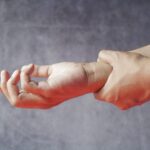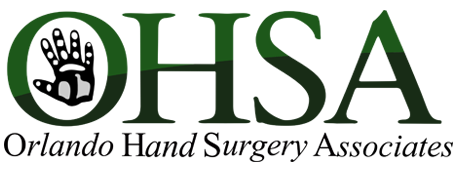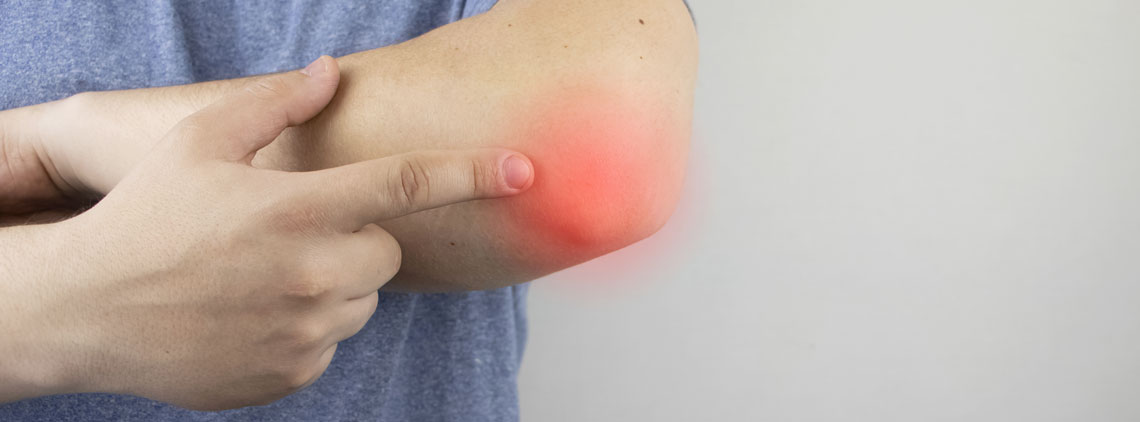
Effective Shoulder Treatment Options: Finding Relief from Pain and Improving Mobility
February 6, 2025
Why Does My Wrist Hurt? 10 Common Causes & When to See a Doctor
March 27, 2025Living with Golfer’s Elbow
Living with golfer’s elbow (medial epicondylitis) can turn simple daily tasks into painful challenges. This common condition affects the tendons connecting your forearm muscles to the bony bump on the inside of your elbow, causing discomfort that can range from mild irritation to severe pain.
You might notice:
- Pain when lifting objects
- Difficulty gripping items
- Discomfort during repetitive arm movements
- Weakness in your hands and wrists
While mild cases might improve with rest and home care, recognizing when to seek professional help can make the difference between proper healing and chronic pain. A specialist at Orlando Hand Surgery Associates can provide targeted treatments to address your specific symptoms and prevent long-term complications.
Early intervention is key
Waiting too long to seek professional care can lead to:
- Chronic pain development
- Limited range of motion
- Decreased grip strength
- Prolonged recovery time
Understanding the signs that indicate the need for specialized care empowers you to make informed decisions about your health and recovery journey.
Understanding Golfer’s Elbow
Golfer’s elbow, medically known as medial epicondylitis, affects the inner side of your elbow where the tendons of your forearm muscles attach to the bony bump. This condition creates inflammation and damage to the tendons responsible for wrist and finger movements.
Common Symptoms
- Sharp pain on the inner side of your elbow
- Radiating discomfort extending to your forearm
- Weakness in your grip strength
- Stiffness in your elbow joint
- Numbness or tingling in your fingers
- Pain that worsens when gripping objects
- Discomfort during wrist flexion activities
Primary Causes
- Repetitive wrist flexion movements
- Forceful gripping actions
- Poor technique during sports activities
- Improper lifting mechanics
- Extended computer mouse use
- Manual labor involving repeated arm motions
- Inadequate warm-up before physical activities
Risk Factors
- Age: Adults over 40 face higher risk
- Occupation: Jobs requiring repetitive arm movements
- Sports participation: Golf, tennis, baseball, weightlifting
- Physical conditioning: Weak forearm muscles
- Equipment issues: Using improper grip sizes or worn equipment
- Medical conditions: Obesity, diabetes, smoking
- Previous elbow injuries
The intensity of symptoms varies among individuals, ranging from mild discomfort to severe pain that interferes with daily activities. Your specific combination of symptoms and risk factors plays a crucial role in determining the most effective treatment approach.
Recognizing the Signs That You Need a Specialist
Your body sends clear signals when it’s time to seek specialized care for golfer’s elbow. Watch for these specific indicators that require professional attention:
1. Pain That Won’t Subside
- Discomfort persisting beyond 6-8 weeks despite rest
- Pain interfering with sleep or daily activities
- Sharp or shooting sensations during simple movements
- Inability to hold light objects without pain
2. Physical Changes
- Visible swelling around the inner elbow area
- Warmth or redness at the affected site
- Stiffness that limits your range of motion
- Weakness in your grip strength
3. Serious Warning Signs
- Fever accompanying elbow pain
- Numbness or tingling extending to fingers
- Visible deformity in the elbow joint
- Inability to straighten or bend your arm fully
4. Impact on Daily Life
- Difficulty performing basic tasks like opening doors
- Unable to lift your coffee cup without pain
- Reduced strength affecting work performance
- Pain that disrupts your sleep patterns
If you experience any combination of these symptoms, scheduling an appointment with a golfer’s elbow specialist at Orlando Hand Surgery Associates can prevent further complications. Early intervention often leads to more effective treatment outcomes and faster recovery times.
When to Seek Professional Help
Conservative treatments like rest, ice, and over-the-counter medications serve as initial steps in managing golfer’s elbow. You need professional medical intervention when these methods don’t provide relief within 2-3 weeks.
Critical Red Flags Requiring Immediate Medical Attention:
- Severe pain that disrupts your sleep patterns
- Inability to carry lightweight objects or perform basic hand movements
- Numbness or tingling extending beyond your elbow
- Visible deformity in your elbow joint
- Clicking or catching sensations during elbow movement
Emergency Signs:
- Intense swelling accompanied by fever above 101°F
- Signs of infection including redness, warmth, or drainage
- Complete loss of elbow mobility
- Sudden sharp pain following an injury or fall
- Visible bone protrusion or severe bruising
Professional intervention becomes crucial if you experience persistent weakness in your grip strength or notice a significant decrease in your range of motion. These symptoms might indicate potential nerve compression or structural damage requiring specialized treatment approaches.
A golfer’s elbow specialist at Orlando Hand Surgery Associates can perform necessary diagnostic tests to identify the root cause of your symptoms. Early intervention helps prevent long-term complications and ensures proper healing of the affected tissues.
What to Expect During Your Appointment with a Golfer’s Elbow Specialist
Your first appointment with a golfer’s elbow specialist sets the foundation for an effective treatment plan. The specialist’s expertise allows for accurate diagnosis and targeted treatment strategies tailored to your specific condition.
Initial Consultation Process
- Detailed discussion of your symptoms and their impact on daily activities
- Review of your medical history, including previous injuries or treatments
- Questions about your occupation and sports activities
- Assessment of any specific movements that trigger pain
Physical Examination
- Evaluation of arm strength and range of motion
- Pressure tests to identify pain points
- Assessment of grip strength
- Examination of neck and shoulder to rule out referred pain
Diagnostic Testing
Your specialist might recommend specific tests to confirm the diagnosis:
- X-rays to check for bone spurs or arthritis
- MRI scans to evaluate soft tissue damage
- EMG (electromyography) to assess nerve function
- Ultrasound imaging to visualize tendon inflammation
Treatment Planning
Based on your evaluation results, your specialist will create a personalized treatment strategy that might include:
- Physical therapy protocols
- Activity modifications
- Pain management techniques
- Specialized injection treatments
- Surgical options if necessary
The specialist will explain each recommended treatment option, including potential benefits and risks. You’ll receive guidance on immediate steps to manage your symptoms and prevent further injury during your recovery process.
Remember to bring any relevant medical records, imaging results, or a list of current medications to your appointment. This information helps your specialist develop the most appropriate treatment approach for your situation.
Treatment Options for Golfer’s Elbow: From Conservative Approaches to Surgery
Your treatment journey for golfer’s elbow typically starts with conservative approaches before considering surgical interventions. Here’s a comprehensive look at your available treatment options:
Conservative Treatment Methods
- Rest and Activity Modification: You’ll need to temporarily avoid activities that trigger pain, allowing your elbow to heal naturally
- Ice Therapy: Apply ice packs for 15-20 minutes, 3-4 times daily to reduce inflammation and manage pain
- Anti-inflammatory Medications: Over-the-counter NSAIDs like ibuprofen can help control pain and swelling
- Physical Therapy Exercises:
- Gentle stretching to improve flexibility
- Progressive strengthening exercises
- Eccentric exercises targeting forearm muscles
- Manual therapy techniques
Specialized Treatment Options
- Counterforce Braces: These specialized bands apply pressure below your elbow joint, reducing strain on affected tendons during activities
- Corticosteroid Injections: Your specialist might recommend targeted injections to provide temporary pain relief in severe cases
- PRP Therapy: Platelet-rich plasma injections can stimulate natural healing processes
Surgical Interventions
When conservative treatments don’t provide adequate relief after 6-12 months, your specialist might recommend surgery. Surgical options include:
- Arthroscopic Debridement: Minimally invasive procedure to remove damaged tissue
- Open Surgery: Traditional surgical approach for severe cases
- Tendon Repair: Addressing significant tendon damage or tears
Your recovery timeline varies based on the chosen treatment approach:
- Conservative treatments: 3-6 months
- Surgical recovery: 4-6 months with rehabilitation
Post-Treatment Rehabilitation
After completing your treatment, rehabilitation plays a crucial role in your recovery. It focuses on restoring strength, flexibility, and function to your elbow joint. Key components of post-treatment rehabilitation include:
- Gradual return to activities: Slowly reintroduce tasks or sports that were previously painful, ensuring you don’t push through discomfort.
- Specific exercises to rebuild strength: Your physical therapist will prescribe targeted exercises to strengthen the muscles around the elbow joint.
- Regular monitoring of symptoms: Keep track of any changes in pain levels or mobility throughout the rehabilitation process.
- Technique modification to prevent recurrence: If certain movements contributed to your golfer’s elbow, working with a coach or trainer can help correct those patterns.
Recovering from Golfer’s Elbow: The Importance of Rehabilitation and Long-Term Care Strategies
Your recovery journey from golfer’s elbow requires dedication and patience. Recovery timelines vary based on severity:
Mild Cases
- 2-4 weeks with proper rest and rehabilitation
- Minimal pain during daily activities
- Quick response to conservative treatments
Moderate Cases
- 4-8 weeks for significant improvement
- Gradual return to activities
- Consistent physical therapy required
Severe Cases
- 3-6 months, especially post-surgery
- Intensive rehabilitation program
- Regular specialist monitoring
Rehabilitation exercises play a crucial role in your recovery success. Your specialist will create a personalized program that includes:
- Progressive strengthening exercises
- Flexibility training
- Grip strength development
- Sport-specific movement patterns
Long-term care strategies focus on preventing future episodes through:
Daily Practices
- Regular stretching routines
- Proper warm-up before activities
- Maintaining correct posture during work and sports
Equipment Modifications
- Using ergonomic tools
- Adjusting sports equipment grip sizes
- Wearing supportive braces during high-risk activities
Lifestyle Adjustments
- Taking regular breaks during repetitive tasks
- Incorporating rest days between intense activities
- Maintaining proper form during sports and exercise
Your commitment to these rehabilitation protocols directly impacts your recovery success rate. Following your specialist’s guidance helps prevent setbacks and ensures optimal healing of the affected tissues.
Preventing Golfer’s Elbow: Tips for Keeping Your Elbows Healthy During Sports Activities
Prevention is the best strategy to avoid golfer’s elbow and its associated complications. Here are proven strategies to protect your elbow health during sports activities:
Strengthen Your Forearm Muscles
- Wrist curls with light weights
- Reverse wrist curls
- Grip strengthening exercises using stress balls
- Resistance band exercises targeting forearm flexors
Perfect Your Form
- Work with a certified instructor to learn proper techniques
- Focus on smooth, controlled movements
- Avoid jerky or sudden motions that stress your elbow
Take Regular Breaks During Repetitive Activities
- Use properly sized equipment for your sport
- Check grip sizes on racquets and clubs
- Replace worn-out grips regularly
- Consider using counterforce braces during activities
Pre-Activity Preparation
- Warm up thoroughly before playing
- Perform dynamic stretches targeting forearm muscles
- Start activities gradually to allow muscles to adapt
- Stay hydrated to maintain muscle flexibility
Training Smart
- Gradually increase activity intensity
- Mix different types of exercises to prevent overuse
- Listen to your body’s signals
- Take rest days between intense training sessions
Remember: If you experience persistent elbow discomfort, consult a specialist at Orlando Hand Surgery Associates. Early intervention can prevent minor issues from developing into serious conditions requiring extensive treatment.
Quick Tip: Incorporate these preventive measures into your regular routine to maintain healthy elbows and enjoy your favorite activities without interruption.
FAQs (Frequently Asked Questions)
What are the common symptoms of golfer's elbow?
Common symptoms of golfer's elbow include tenderness on the inner elbow, radiating pain down the forearm, stiffness in the elbow joint, and difficulty with gripping or lifting objects.
When should I see a specialist for golfer's elbow?
You should consult a golfer's elbow specialist if you experience persistent pain that does not improve with rest or over-the-counter medications, significant swelling accompanied by fever or other systemic symptoms, or an inability to bend your elbow or perform daily tasks.
What treatment options are available for golfer's elbow?
Treatment options for golfer's elbow range from conservative methods such as rest, ice therapy, anti-inflammatory medications, and physical therapy to surgical interventions if conservative treatments fail. Rehabilitation exercises play a crucial role in recovery.
How long does it take to recover from golfer's elbow?
The recovery timeline for golfer's elbow varies based on severity. Mild cases may improve within a few weeks, while moderate to severe cases could take several months. Adhering to rehabilitation exercises is essential for optimal healing outcomes.
What preventive measures can I take to avoid developing golfer's elbow?
To prevent golfer's elbow, engage in strengthening exercises targeting forearm muscles, use appropriate sports equipment suited for your activity (like correct grip sizes), and ensure proper technique during movements to reduce strain on your elbows.


